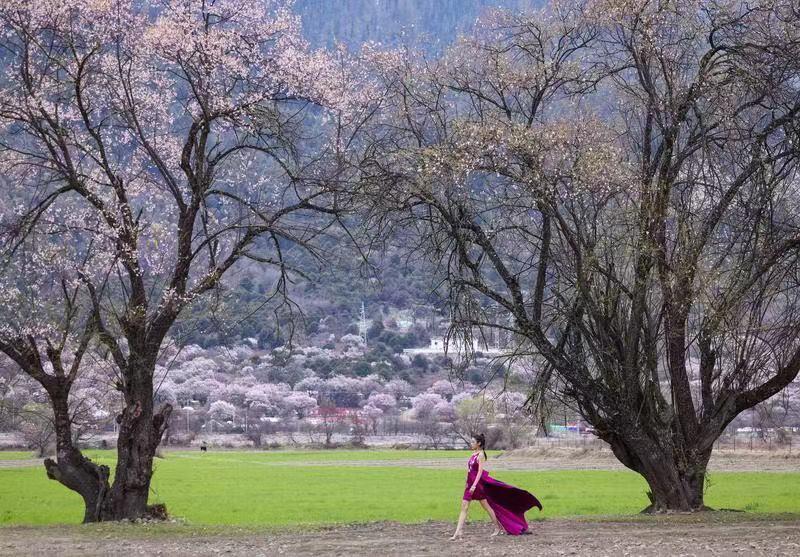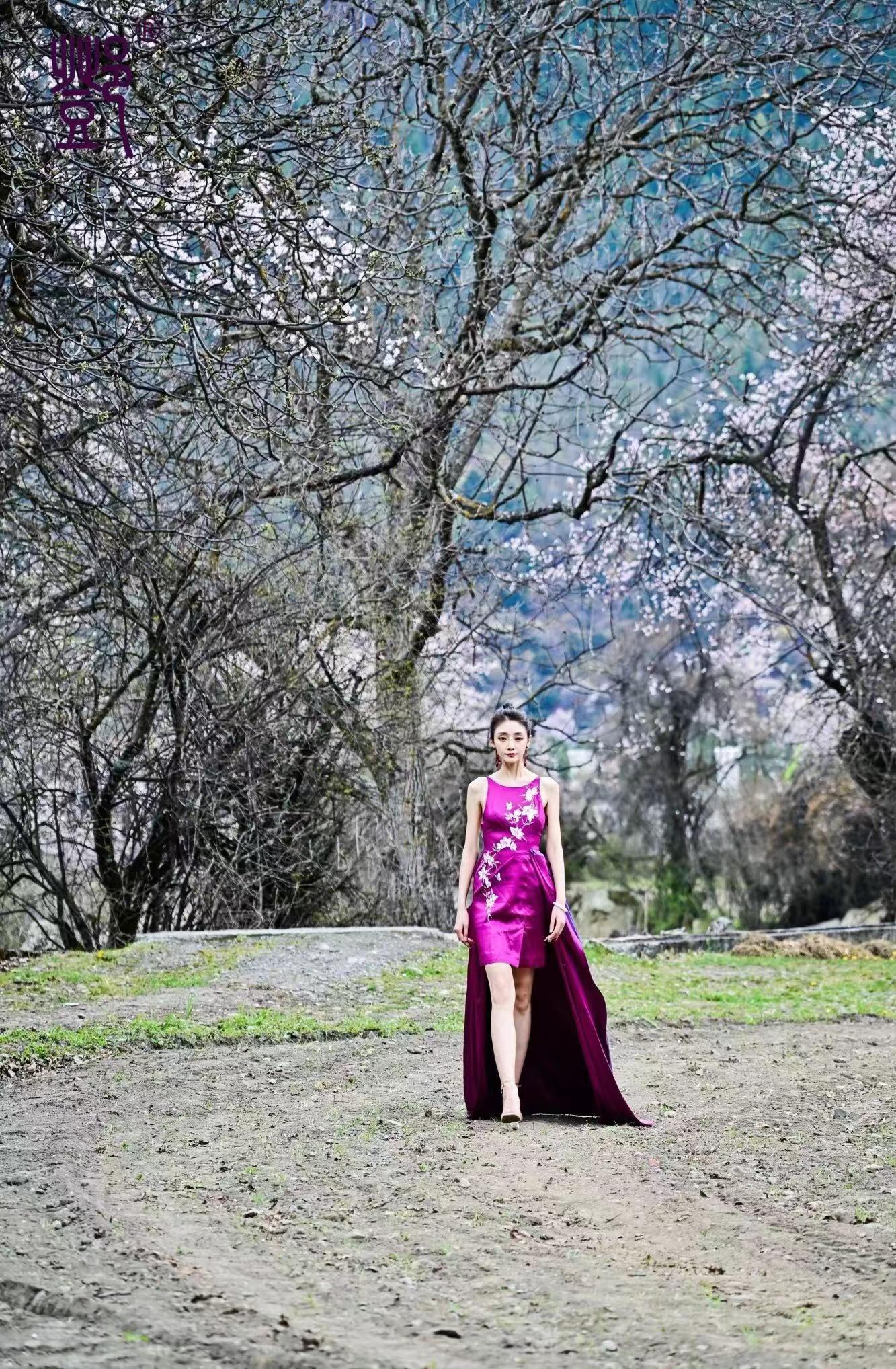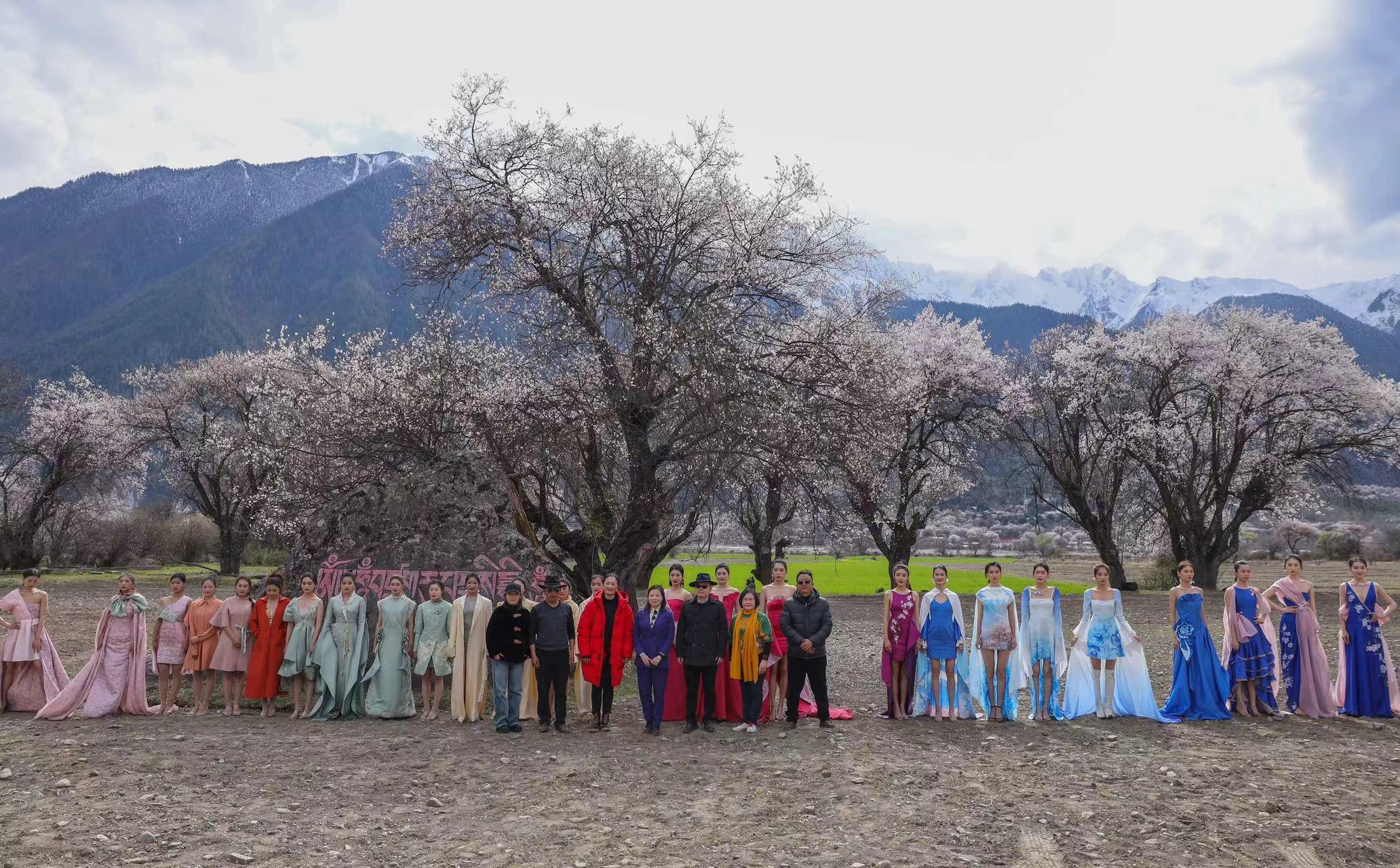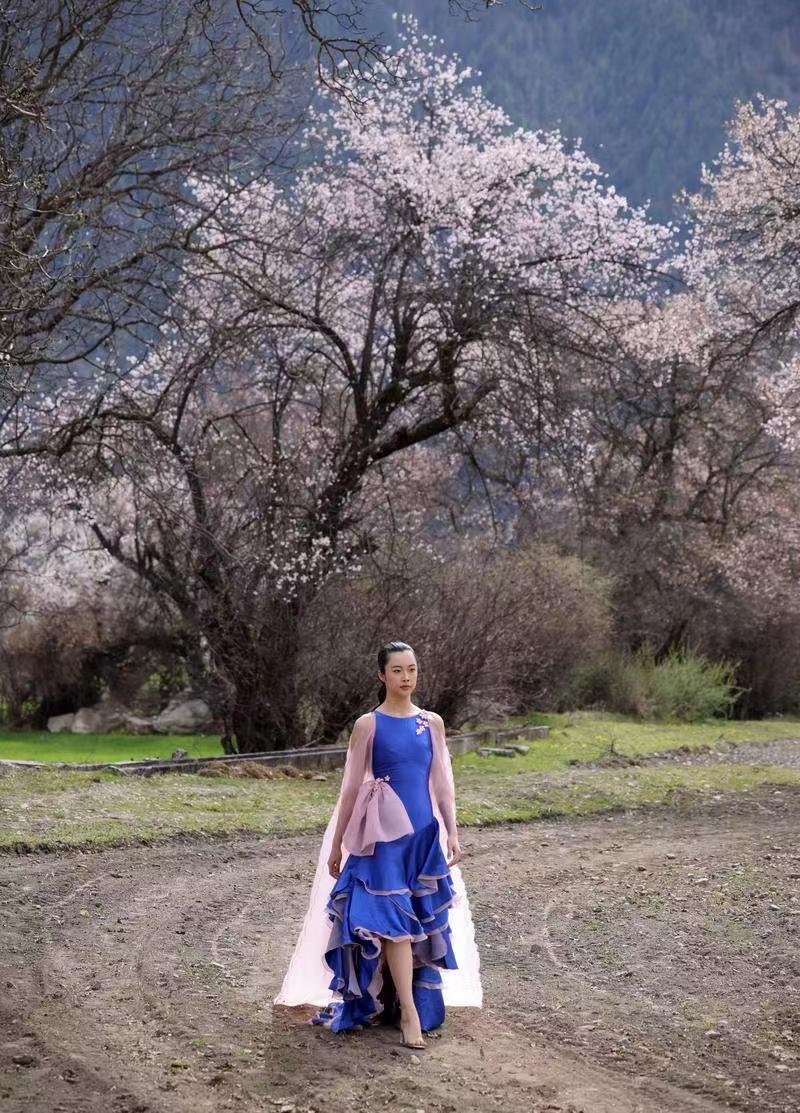On March 30th, during the Peach Blossom Festival in Linzhi, Tibet, a live show named "Where Peach Blossoms Bloom" was staged. In the Gutong Village in Bomi County, models wearing long dresses combining Lingnan features and Tibetan elements walked on the half-wet mud, posed and showed off under the peach blossoms.

Designer Deng Zhaoping, who led the show, was moved to tears backstage. She is one of China's top fashion designers and has won several awards, including the "China Top Ten Fashion Designers" award in 2003 and the "Best Women's Wear Designer" award in 2016. In 2021, she won the highest prize in Chinese fashion design, the "Golden Summit Award".
A Guangdong designer falls in love with Tibet
Deng Zhaoping was deeply impressed by the colorful ethnic costumes and architectural colors of Tibet when she first visited the region in 2000.
Influenced by Tibetan culture, she held a fashion show with the theme of "Ancient Tea Horse Road" at the China Fashion Week in 2003. She covered the T-stage with yellow leaves, and models wearing dark green, light brown, and orange Tibetan ethnic costumes walked on the fallen leaves.
 In September 2019, Deng went to Linzhi, Tibet for inspiration. Upon learning that the Peach Blossom Festival was held in Bomi County every March, she decided to stage her fashion show there. For this live show, she decided to combine the Guangzhou customs of using peach blossoms to decorate houses during the Chinese New Year with the Peach Blossom Festival in Linzhi. In terms of costume design, she blended Lingnan-style fabrics with elements such as glaciers and snow mountains in Tibet, and also incorporated ethnic cultural elements of the Menba and Luoba ethnic groups in Linzhi.
In September 2019, Deng went to Linzhi, Tibet for inspiration. Upon learning that the Peach Blossom Festival was held in Bomi County every March, she decided to stage her fashion show there. For this live show, she decided to combine the Guangzhou customs of using peach blossoms to decorate houses during the Chinese New Year with the Peach Blossom Festival in Linzhi. In terms of costume design, she blended Lingnan-style fabrics with elements such as glaciers and snow mountains in Tibet, and also incorporated ethnic cultural elements of the Menba and Luoba ethnic groups in Linzhi.
Fashion show on the mud
Costume design and show planning gradually took shape in Deng Zhaoping's mind, but it was not an easy task to hold a fashion show at an altitude of 3,000 meters.
The firstchallenge was the severe altitude sickness. The director and some models in the team were suffering from headaches and had to inhale oxygen while doing rehearsals.
Recalling the weather changes in Bomi, Deng was full of emotion. At the end of March, the temperature in Bomi was often as low as 3 degrees Celsius, raining one moment and sunny the next. When models wearing thin clothes walked in the slippery mud, their high heels often got stuck in the mud, and their long skirts dragged on the muddy ground. Despite this, Deng insisted on not building a T-stage, as she did not want artificial elements to destroy this pristine land.
 After the hour-long live show, Deng Zhaoping joined the models on stage to take a bow. She was accustomed to applause, but in Bomi, looking at the peach blossoms and snow-capped mountains around her, stepping on the mud, Deng seemed to hear the applause given to her by the snowy plateau.
After the hour-long live show, Deng Zhaoping joined the models on stage to take a bow. She was accustomed to applause, but in Bomi, looking at the peach blossoms and snow-capped mountains around her, stepping on the mud, Deng seemed to hear the applause given to her by the snowy plateau.
"Lingnan culture is the basis of my design"
Deng Zhaoping is a local of Guangzhou, and Lingnan culture has always been her source of inspiration and root of design.
She likes to use Lingnan elements, such as Lingnan fruits and flowers, Xiguan houses, Mashi Street, and Tanglong Gate, in the patterns of her fabrics. In her fashion show that won the Golden Summit Award, Deng Zhaoping was inspired by the Cantonese morning tea culture, and her designs showed classic Cantonese morning tea snacks such as steamed shrimp dumplings and steamed vermicelli rolls. She hopes that these traditional elements can enter people's daily lives. "I hope that customers can wear clothes with Lingnan culture to work and travel, instead of leaving them in situations that are far from ordinary life."
雪域高原“泥地时装秀”让顶级设计师流下热泪
3月30日,西藏林芝桃花节,一场名为“桃花盛开的地方”实景大秀正在上演。在波密县古通村漫山遍野的桃花下,模特们穿着结合了岭南特色和藏区元素的长裙,在半湿的泥地上走台步、定点、摆造型。
在后台,主导这场时装秀的设计师邓兆萍激动得流下眼泪。她在2003年就获得了中国十佳时装设计师称号,2016年荣获中国最佳女装设计师的称号,在2021更是荣获中国时装设计最高奖“金顶奖”。
广东设计师的西藏情缘
2000年第一次进藏,藏区的民族服饰和建筑色彩豪放明艳,给了邓兆萍带来极大的视觉冲击。
受西藏文化的影响,邓兆萍在2003年的中国国际时装周上,以“茶马古道”为主题完成了一场时装秀。她在T台上铺满了枯黄的落叶,模特穿着暗绿色、浅棕色和橙色的藏族元素服装,在落叶上走过。
2019年9月,邓兆萍第一次去西藏林芝采风。听说林芝市波密县在每年3月都会举办桃花节,她决心把她的服装实景秀放在这里。策划这场实景秀时,邓兆萍决定把广州春节插桃花的习俗和林芝桃花节结合在一起。在服装设计上,她将有岭南特色的服装面料和藏区的冰川、雪山等元素融合,还加入了林芝当地门巴族和珞巴族的族群文化元素。
泥地上的时装秀
服装设计和秀场策划在邓兆萍的脑海中逐渐成形,但要在海拔3000米的高原完成一场时装大秀,并非易事。
首先是剧烈的高原反应,团队里的导演和几个模特头疼欲裂,一边吸氧一边坚持彩排。
回忆起波密的天气变化,邓兆萍感慨良多。3月底时,波密的气温时常低至3摄氏度,一时下雨,很快又出太阳。模特穿着单薄的服装走在湿滑的泥土上,高跟鞋时常嵌进泥里,衣服的长裙摆在泥地上拖行。即便如此,她也坚持不搭建T台,她不想让人工元素破坏这片净地。
一个小时的实景大秀落幕,邓兆萍随模特一起上场谢幕。她早已习惯了掌声,但在波密,看着四周的桃花和雪山,踩着脚下的泥土,邓兆萍仿佛听见了雪域高原给她的掌声。

“岭南文化是我设计的底色”
邓兆萍是一名地道的“老广”,岭南文化始终是她的灵感来源和设计底色。
她在服装面料的图案上喜欢运用岭南花果以及西关大屋、麻石街、趟栊门等元素。在获得金顶奖的时装秀里,邓兆萍以广州早茶文化中的“一盅两件”元素为切入点,模特身着绘有虾饺、肠粉、烧卖、叉烧包等图案的服装走上T台。她希望这些传统元素能走入人们的日常生活里。“我希望顾客能穿着带有岭南文化的衣服去上班、旅游,而不是让它停留在离普通生活很遥远的情景里。”
文|羊城晚报全媒体记者 谭洁文
图|受访者提供
翻译|刘佳慧
责编|王瑜瑛









